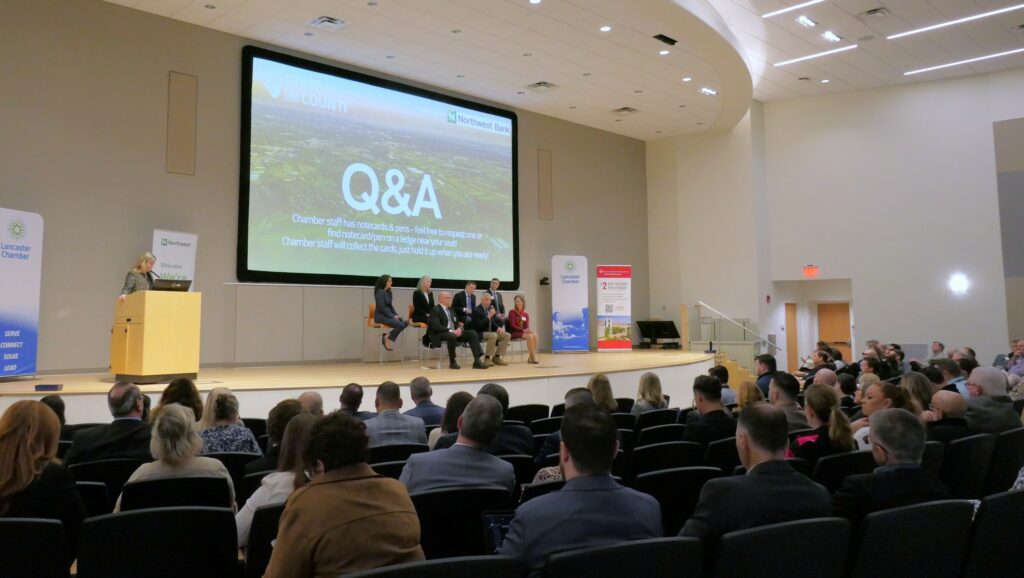Lancaster County’s comprehensive plan, Places 2040, stresses the need to “Think Beyond Boundaries.”
That’s the approach the Lancaster Chamber highlighted Friday morning at its 2024 “State of the County” presentation. An array of local officials took the stage to explain how they are partnering with their colleagues and developing strategies around land use, transportation, economic development, environmental preservation and more.

The need for regional approaches is evident, chamber President Heather Valudes said in her opening remarks.
Lancaster County has some of the most beautiful countryside in the world, and its residents deeply value its open space and want to preserve it. At the same time, land scarcity is becoming a concern for the county’s economy and business climate. Companies are struggling to find suitable land for new plants and offices, and when they do expand, high housing prices are making it difficult to recruit the workforce they need.

Regional planning and collaboration can address those issues and others, Commissioner Ray D’Agostino said. Done right, it can reduce duplication of services and increase efficiency; improve economic competitiveness and enhance quality of life.
“We’ve been doing it pretty well,” he said. Lancaster County has 60 municipalities, each with jurisdiction over its own planning and zoning. Since Places 2040’s publication, he said, the county Planning Department has helped municipalities develop and adopt 14 regional plans and another seven are under way.
They touch every corner of the county, whether urban, suburban or rural, as the rest of the morning’s speakers illustrated.
Read the plans
Click these links to access the plans discussed at State of the County 2024:
- Our Future Lancaster (Lancaster city’s comprehensive plan)
- Comprehensive Plan for the Cocalico Region
- Southern Lancaster County Comprehensive Plan
- Bridgeport Crossroads Transportation & Land Use Study
Our Future Lancaster
Lancaster city adopted its comprehensive plan last fall, the first since 1993. The city is following up with three focused “small area plans,” Mayor Danene Sorace said:
- East End: This plan will set the stage for redeveloping the County Prison site once corrections operations move to the new facility in Lancaster Township;
- Northwest Gateway: This will examine ways to promote high-density walkable development connecting the neighborhoods around Clipper Magazine Stadium, the Lancaster Behavioral Health Hospital and the Franklin & Marshall College properties around Harrisburg Avenue and West Liberty Street.
- Sunnyside Peninsula: This will kick off the city’s plans to establish a nature preserve on the peninsula and build an environmental center, part of an overall strategy to reimagine the Conestoga River corridor as an environmental and recreational resource.
Meanwhile, the city is pushing ahead with efforts to expand housing, improve public transit and biking and expand access to childcare. The latter is a major impediment to job seekers, especially single mothers.
“When we talk about a housing crisis, we’re also talking about a childcare crisis,” she said. “… This continues to be a key barrier to our collective success.”

Bridgeport
Four municipalities abut each other in the area of the Bridgeport Crossroads: The city, East and West Lampeter townships and Lancaster Township. Because of that, there has been little coordination of land use, transportation or public services.

“It’s very auto-centric,” said Tara Hitchens, assistant township manager at East Lampeter Township. The four municipalities began working on a joint transportation and land use study in 2017; the result was released in summer 2021.
There were profound disagreements to resolve, Hitchens said: among other things, it took eight attempts to envision a reconfiguration of the area’s central intersection that all the partners could accept.
The first tangible outcome of the project is coming soon, she said: Streetscape enhancements along East King Street. Other recommendations include the addition of sidewalks and intersection improvements; traffic calming in residential areas; and the development of a trail linking East King Street to Conestoga Pines Park along the Conestoga River.

Boroughs and rural townships

Quarryville Borough Manager Scott Peiffer and Denver Borough Michael Hession said that collaborating on their respective areas’ regional plans strengthened the ties among the various stakeholders.
The Solanco regional plan encompasses 10 townships and the boroughs of Quarryville and Christiana. Residents are adamant that Solanco retain its rural character, Peiffer said. Yet it still needs to accommodate some growth: The solution proposed in the plan is to focus it in the two boroughs, which have the infrastructure and layout to absorb additional development and increased density.
Exemplifying the increased intermunicipal collaboration, Peiffer said, is the progress being made on a potential mountain bike recreational area off the Enola Low Grade Rail Trail. The project requires buy-in from Quarryville, Eden Township, Providence Township and a private entrepreneur, and it’s exciting to see everyone coming together to make it happen, he said.

The Cocalico Regional Plan, meanwhile, encompasses Adamstown, Denver and East and West Cocalico townships. One big finding, Hession said: The area has more jobs than housing.
The housing stock is aging and consists disproportionately of detached single-family homes. The plan also identified shortcomings in the area’s transportation network: There’s a lot of congestion on the main roadways and getting to the area’s main employers is difficult or impossible without a car.
Today, there are 660 new housing units either under construction or in the pipeline, Hession said, and two transportation infrastructure projects are in the works that will improve access to the industrial area along Denver’s east side, home to High Concrete Group and other companies that employ a full third of the borough’s workforce.

County priorities
D’Agostino’s fellow commissioners Josh Parsons and Alice Yoder also took the stage Friday, with Parsons outlining the county’s priorities and Commissioner Alice Yoder, who took office in January, summarizing her background and goals.
Parsons said county government’s strengths include its low property tax rate, unchanged for 11 years; its track records on public safety and farmland preservation; its stewardship of public infrastructure, reflected in its recently completed bridge renovation program; and its transparency.
“We’re a level of government that gets things done,” he said.
Yoder said her approach is collaborative and data-driven, focused on equity and attentive to budget constraints. She said she has five priorities as commissioner: Ensure fair, secure elections; Improve county behavioral health and substance use treatment services; address affordable housing and homelessness; ensure the new County Prison is state-of-the-art and focused on rehabilitation and successful reentry; and ensure better access to population health data by creating a county health department.
Commissioners Parsons and D’Agostino have opposed the idea of a health department, saying it would not be worth the added cost and bureaucracy.






